Long ago in Bethlehem, as the Holy Bible recounts, a night unfolded that forever altered the course of history—discover the enduring legacy.
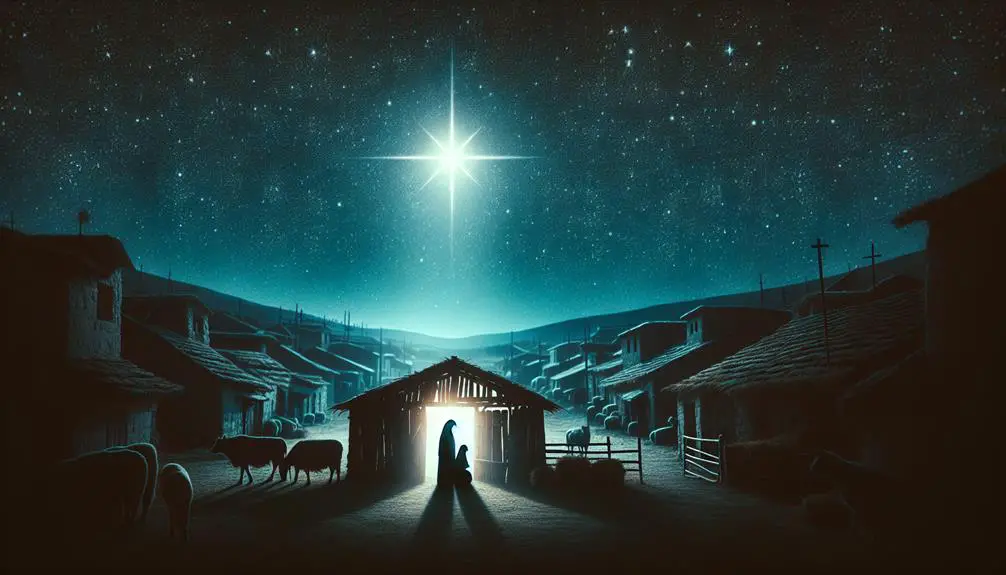
Long Time Ago in Bethlehem so the Holy Bible Say
Just as the classic carol whispers of a monumental night in Bethlehem, so too does the Holy Bible recount a tale that has echoed through millennia.
You're about to step into a narrative woven with prophecy, celestial marvels, and humble beginnings that reshaped the world.
From the prophetic foretellings that hinted at its significance to the night sky alight with a guiding star, Bethlehem's story isn't just a recount of history; it's the beginning of a legacy.
Let's unravel how this singular event's global impact continues to influence cultures and beliefs, leaving an indelible mark on humanity's tapestry.
Key Takeaways
- Bethlehem's significance extends beyond geography, symbolizing divine intervention and the fulfillment of ancient prophecies.
- The birth of Jesus in Bethlehem precisely fulfills Old Testament Messianic predictions, underscoring the town's prophetic importance.
- The event highlights the unexpected ways God's plans unfold, using humble settings for monumental purposes.
- Bethlehem's story is a testament to faith's power, connecting historical events with the enduring legacy of divine promise.
The Setting: Bethlehem's Significance
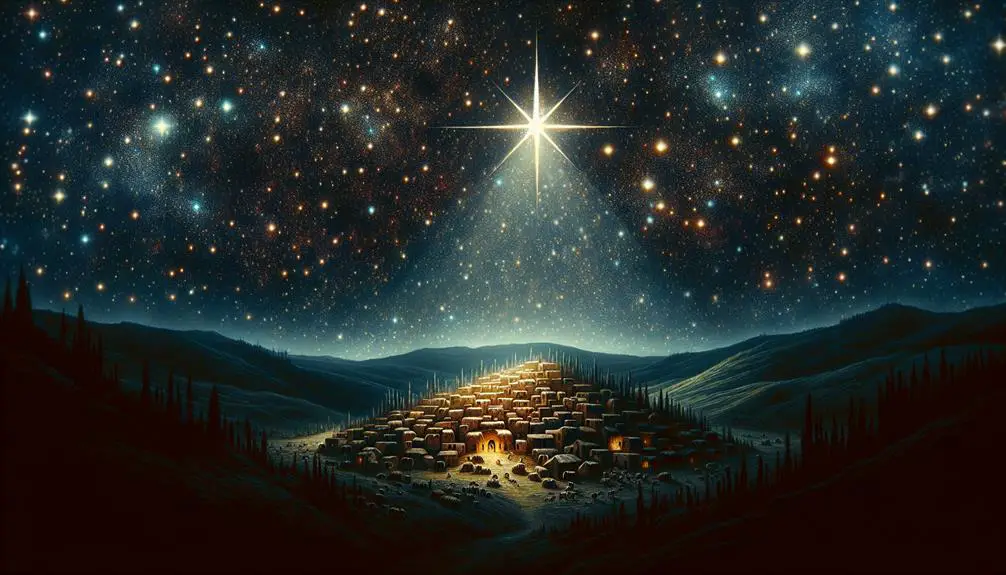
Bethlehem's profound significance in the biblical narrative isn't just geographical; it's deeply entwined with the fulfillment of prophecy and the birthplace of Jesus Christ, marking it as a pivotal location in Christian faith. Its geography, nestled in the Judaean Hills, some 10 kilometers south of Jerusalem, not only positioned it as a crucial crossroads in ancient trade routes but also as a symbolic bridge between heaven and earth in the Christian narrative. This positioning bestowed upon Bethlehem an economic significance that transcended mere commerce, intertwining it with the spiritual economy of salvation history.
You'll find that Bethlehem's economic importance was multifaceted. Historically, its fertile lands and proximity to critical trade routes supported its inhabitants and made it a significant player in the region's agricultural and trade economies. Yet, the town's true value can't be measured in economic terms alone. Its role in the biblical story elevates its significance, transforming it from a mere point on the map to a key player in the divine narrative. Through this lens, Bethlehem's geography and economic vitality become backdrop and foundation for its prophetic and spiritual significance, underlining its role in God's redemptive plan for humanity.
Prophetic Foretellings
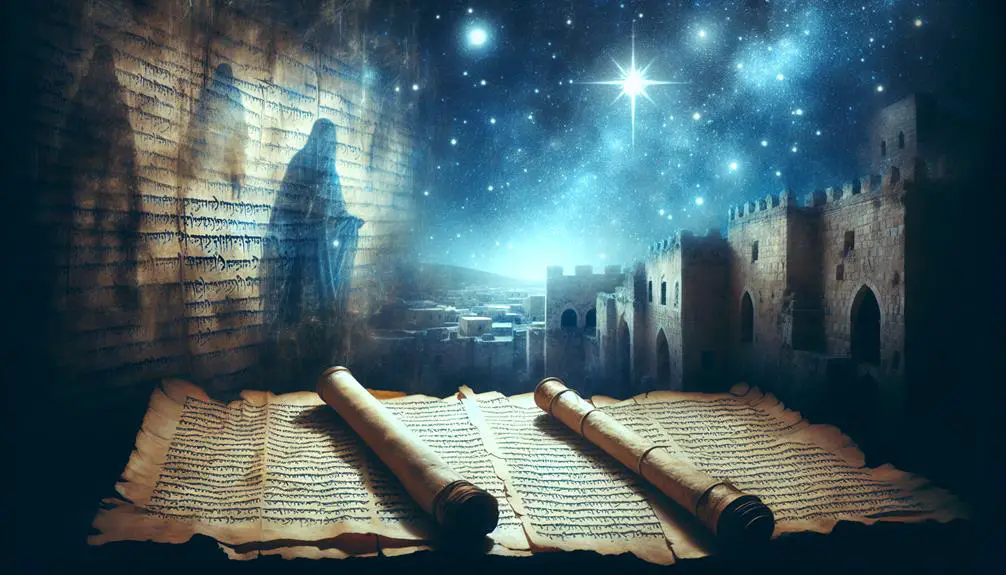
You'll find that the Bible's prophetic foretellings, particularly those concerning the Messiah, hold an intricate layer of significance.
The fulfillment of Messianic prophecies, especially within the context of Bethlehem, underscores the precision of ancient predictions.
This realization not only affirms the faith of believers but also offers a scholarly lens through which to examine the interconnectedness of prophecy and historical events.
Messianic Prophecies Fulfilled
Throughout the pages of the Old Testament, numerous prophecies foretold the coming of a Messiah, each meticulously fulfilled in the life of Jesus Christ. These prophecies, rich in genealogical verification and steeped in historical accuracy, provide a solid foundation for faith.
Consider the depth and precision of these foretellings:
- Born of a Virgin: Mirroring the prophecy of Isaiah, Jesus's birth to Mary aligns perfectly.
- Descendant of David: Genealogical records in the Gospels confirm Jesus's lineage, fulfilling royal prophecies.
- Suffering Servant: Isaiah's detailed portrayal of a suffering Messiah matches Jesus's crucifixion.
- Resurrection: Psalms and Isaiah hint at a resurrection, a cornerstone event in Christian faith that Jesus fulfills.
These fulfilled prophecies underscore a narrative of divine orchestration, inviting believers to delve deeper into the historical and spiritual journey of faith.
Bethlehem's Prophetic Significance
In analyzing the biblical narrative, it becomes evident that the town of Bethlehem holds a pivotal role in the fulfillment of messianic prophecies. Nestled in the Judean hills, Bethlehem's geography isn't just a backdrop; it's steeped in symbolic significance, embodying themes of humility and promise. This small, seemingly insignificant town is spotlighted in prophecy, highlighting God's penchant for using the unexpected to fulfill divine plans.
The cultural context of Bethlehem further amplifies its prophetic importance. A town known for its pastoral economy and Davidic lineage, it serves as a bridge between ancient promises and their fulfillment. Here, the juxtaposition of simplicity and divine purpose underscores a profound theological principle: God's choices often defy human expectations, revealing a deeper wisdom in the narrative of redemption.
Ancient Predictions Realized
The fulfillment of ancient prophecies in Bethlehem isn't merely coincidental but marks a deliberate divine intervention in human history. This event underscores the profound intersection of faith and history, where historical verification and cultural interpretations intertwine.
To deepen your understanding, consider these aspects:
- Historical Verification: Archaeological findings and historical records affirm the prophecies' authenticity, providing tangible evidence of their realization.
- Cultural Interpretations: The events in Bethlehem have been interpreted through various cultural lenses, enriching the narrative's complexity and significance.
- Divine Precision: The accuracy with which these prophecies were fulfilled highlights a meticulous divine plan.
- Faith Affirmation: For believers, these fulfilled predictions reinforce faith, showcasing the reliability and omnipotence of the divine.
Analyzing these elements offers a comprehensive understanding of how ancient predictions in Bethlehem weren't only realized but also served as a testament to faith's enduring power.
The Holy Night Unveiled
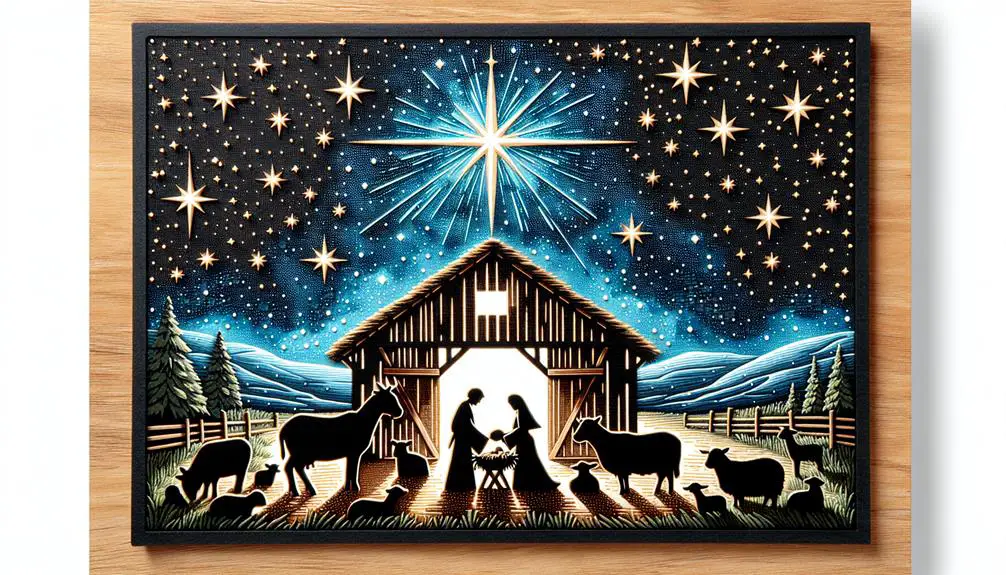
Under the celestial canopy, that holy night unfolded as a pivotal moment in Christian faith, weaving a narrative of divine intervention and human salvation. This event, central to the Christian doctrine, has been subject to modern interpretations and cultural variations, each enriching the story with local hues and insights, yet preserving its core essence. The birth of Jesus in Bethlehem isn't merely a historical account; it's a tapestry of prophecy fulfillment, divine orchestration, and the inception of a new covenant between the divine and humanity.
Scholars and theologians have long debated the intricacies of this night, analyzing scriptural descriptions and historical contexts to gain a deeper understanding of its significance. This scholarly examination reveals how the holy night serves as a bridge between the Old and New Testaments, fulfilling ancient predictions while setting the stage for Jesus' mission of redemption. Cultural variations in celebrating this event underscore its universal appeal and the diverse ways in which the narrative of hope and salvation resonates across different societies.
Thus, the holy night, veiled in mystery and steeped in divine purpose, continues to inspire faith, scholarly inquiry, and cultural expression, highlighting its enduring relevance in a constantly evolving world.
Shepherds and Angels
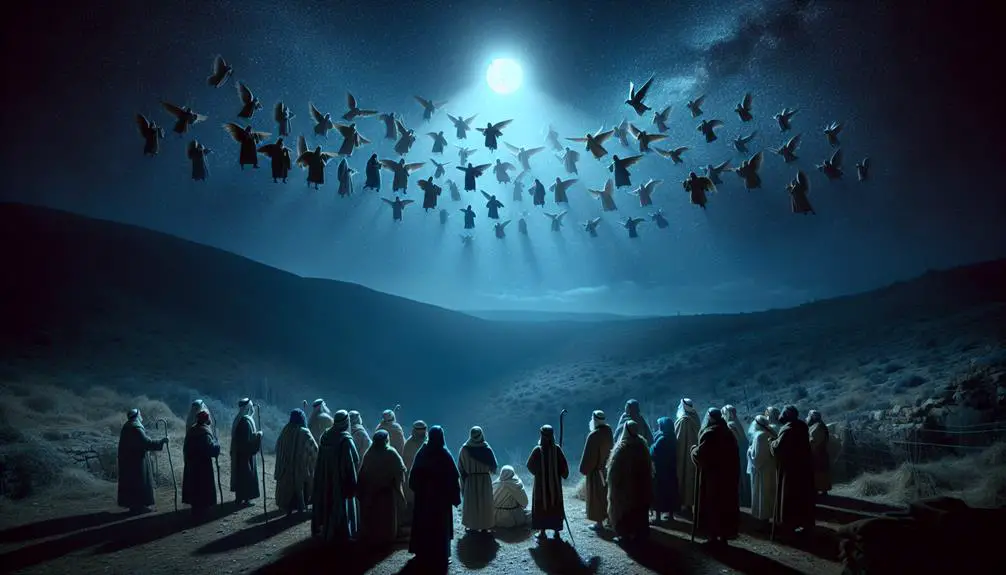
You must consider the profound implications of the angelic announcement to the shepherds, a pivotal moment that bridges heaven and earth in the biblical narrative.
This nighttime encounter not only highlights the humility and accessibility of the divine message but also sets a precedent for following heavenly guidance with unwavering faith.
Analyzing these events sheds light on the broader theological themes of revelation and response that are central to the Christian faith.
Angelic Announcement to Shepherds
Frequently, in the narrative of the Nativity, the angelic announcement to shepherds stands as a pivotal moment of divine revelation and human response. This encounter underscores the shepherd's livelihood, emphasizing their humble status, and contrasts it with the glorious angelic characteristics, thereby highlighting a profound theological statement on God's grace.
- Shepherd's Livelihood: The shepherds' simple, labor-intensive life is illuminated against the backdrop of divine intervention, signifying God's preference for the humble.
- Angelic Characteristics: The angels exude glory and holiness, symbolizing heaven's reach to earth.
- Divine Revelation: This moment marks a direct communication from God, signifying the importance of the message.
- Human Response: The shepherds' reaction showcases a model of faith and obedience, setting a precedent for accepting divine encounters.
This analysis reveals the depth of God's message and the chosen recipients' significance.
Shepherds' Nighttime Encounter
Building on the profound theological insights from the angelic announcement, we now explore the shepherds' nighttime encounter with the angels, a moment that further illuminates the divine's interaction with humanity.
As the shepherds were tending to their flocks during nighttime grazing, they were suddenly enveloped in an extraordinary celestial phenomena. This wasn't just a natural occurrence; it was a divine manifestation. The skies, usually a silent witness to their nightly labors, became a canvas for the divine message.
This encounter underscores the accessibility of the divine to all strata of society, highlighting that sacred revelations aren't confined to the temples and the learned, but are generously extended to those in the humblest of circumstances, tending their flocks under the starry sky.
Following the Heavenly Guidance
Emboldened by their celestial encounter, the shepherds embarked on a journey, guided by the promise of divine revelation, to witness the fulfillment of ancient prophecies. Their path, illuminated not just by the stars but by the profound sense of purpose that celestial navigation instilled within them, serves as a testament to the power of divine guidance.
- Divine Dreams: Dreams often served as a conduit for divine messages, guiding individuals on their destined paths.
- Celestial Navigation: The stars offered more than just light; they provided direction, leading the shepherds to Bethlehem.
- Ancient Prophecies: The fulfillment of these prophecies was a cornerstone of faith, showing that divine promises come to fruition.
- Heavenly Encounters: Such encounters underscored the tangible connection between the divine and the earthly realm, guiding humanity through the ages.
The Wise Men's Journey
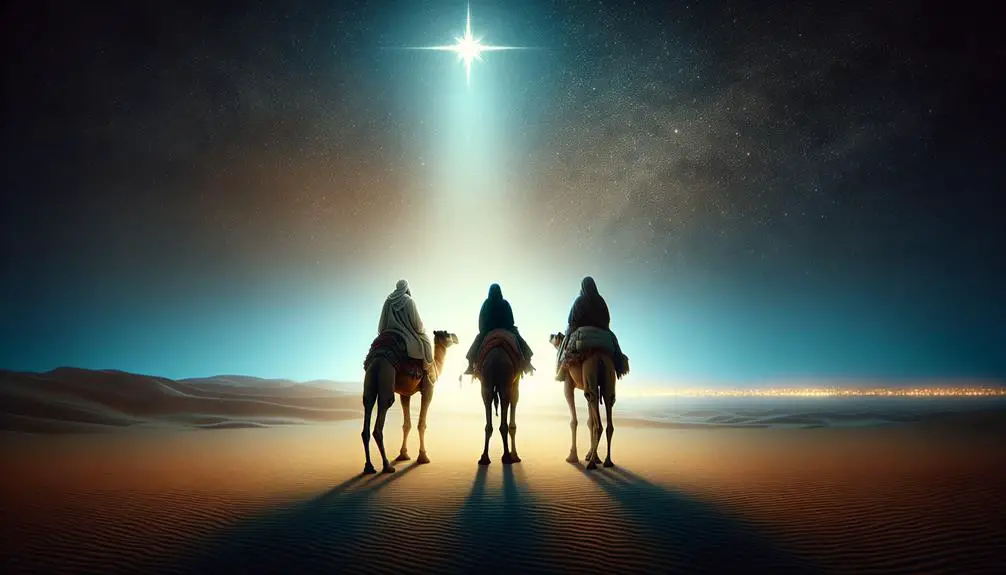
Guided by a celestial phenomenon, the Wise Men embarked on a perilous journey, seeking the newborn king prophesied in ancient scriptures. This trek wasn't merely a physical voyage; it was a profound manifestation of faith and determination. The path they followed was illuminated not just by the star they pursued but also by their unwavering belief in the fulfillment of prophecy.
As you delve deeper into this narrative, it's essential to consider the layers of Magi myths and the Astronomical debates that have ensued. These discussions aren't mere academic exercises; they're integral to understanding the historical and theological context of the Wise Men's journey.
Scholars and theologians alike have pondered over the identity of the star that guided the Magi. Was it a miraculous sign, a comet, a supernova, or a planetary conjunction? This debate intersects faith and science, challenging us to explore how divine intervention can manifest within the natural world.
The journey of the Wise Men thus serves as a bridge between the celestial and the terrestrial, inviting you to reflect on the interplay between divine prophecy and human action. It's a reminder that faith often requires us to embark on journeys, not just physically but spiritually, towards understanding deeper truths.
Gifts of Deep Meaning
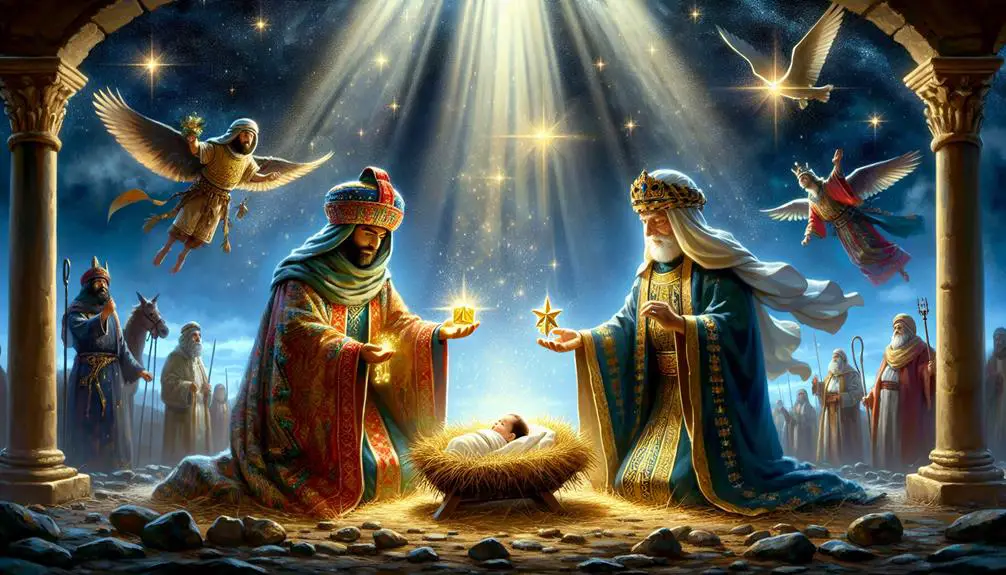
Upon reaching their destination, the Wise Men presented three gifts to the newborn king, each laden with profound symbolic significance that intertwines faith, prophecy, and scholarly interpretation. These gifts weren't chosen at random but were deeply rooted in cultural traditions and the practice of gift exchange, each carrying a significant meaning:
- Gold symbolizes kingship on earth, acknowledging the infant as a sovereign.
- Frankincense represents deity, recognizing the divine nature of the child.
- Myrrh is associated with suffering and death, foreshadowing the crucifixion.
The act of gift-giving by the Wise Men goes beyond mere cultural traditions; it's an embodiment of the recognition of Jesus Christ's multifaceted role as King, God, and Sacrificial Lamb. This narrative invites you to explore the depths of faith through the lens of scholarly interpretation, urging a reflection on the profound implications of these gifts. The gift exchange between the Wise Men and the Holy Family stands as a testament to the interconnectedness of prophecy, faith, and the acknowledgment of Jesus' mission on earth.
The Star of Bethlehem

Exploring further into the narrative of the Nativity, the Star of Bethlehem emerges as a celestial phenomenon that has captivated scholars and believers alike, symbolizing divine guidance and the fulfillment of prophecy. You've likely heard various interpretations, each intertwining astronomical theories with historical debates.
The discussion around the Star of Bethlehem isn't just about identifying a celestial event. It's a quest to understand how the divine intersects with the cosmos. Scholars sift through historical records and astronomical data, aiming to pinpoint the star's nature. Was it a supernova, a comet, or perhaps a planetary conjunction? These questions fuel ongoing research and debate.
To give you a clearer picture, consider the following table, which highlights key theories and their proponents:
Theory |
Description |
Proponent |
|---|---|---|
Supernova |
An exploding star |
Historical records |
Comet |
A celestial object with a tail |
Chinese astronomers |
Planetary Conjunction |
Alignment of planets |
Johannes Kepler |
Miracle |
A divine, supernatural occurrence |
Faith-based interpretations |
This table encapsulates the diverse perspectives surrounding the Star of Bethlehem. Each theory reflects the intersection of faith, science, and history, enriching our understanding of this biblical event.
Legacy and Global Impact
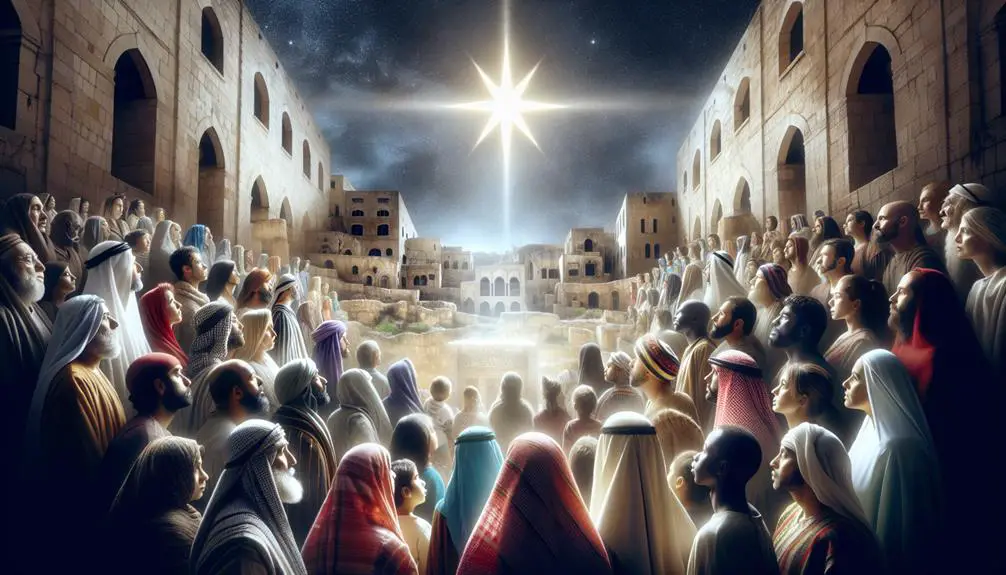
The legacy of the Star of Bethlehem extends far beyond its initial appearance, significantly influencing cultures and faiths around the globe. This celestial phenomenon has become a symbol of hope and guidance, deeply embedded within the fabric of various cultural festivals and modern interpretations. Its impact is multifaceted, touching upon art, music, and literature, while also serving as a spiritual beacon across centuries.
To understand its wide-reaching influence, consider the following aspects:
- Cultural Festivals: The Star is central to Christmas celebrations worldwide, inspiring events that bring communities together in reflection and joy.
- Artistic Inspiration: Countless artists have depicted the Star, each interpretation reflecting the societal values and religious sentiments of its time.
- Scholarly Analysis: Academics continue to explore the Star's historical and astronomical origins, bridging faith with scientific inquiry.
- Modern Interpretations: In today's digital age, the Star is reimagined through various media, from movies to virtual reality experiences, making its story accessible to newer generations.
Frequently Asked Questions
How Has the Historical Architecture of Bethlehem Evolved Post-Biblical Times to Accommodate the Influx of Pilgrims and Tourists?
You've noticed that Bethlehem's historical architecture has morphed significantly post-biblical times, adapting to the surge of pilgrims and tourists. Urban development initiatives have carefully integrated modern needs with ancient sanctity.
The city's architectural styles have diversified, blending traditional designs with contemporary features, ensuring both the preservation of sacred spaces and the accommodation of visitors. This evolution reflects a deep respect for faith while embracing the practicalities of modern pilgrimage and tourism.
What Are the Lesser-Known Local Customs or Traditions in Bethlehem That Celebrate the Birth of Jesus Outside of the Mainstream Christmas Festivities?
In Bethlehem, you'll find unique traditions celebrating Jesus' birth, beyond the well-known Christmas events. Shepherd reenactments and Star processions stand out, deeply embedding faith into local culture.
These customs, rich in symbolism, offer a reflective, scholarly perspective on the nativity story. They're not just performances but acts of faith, drawing participants and observers into a profound communal experience, honoring the historical and spiritual significance of Jesus' birth in this ancient city.
How Has Modern-Day Bethlehem's Socio-Political Climate Affected the Preservation and Accessibility of Biblical Heritage Sites?
In modern-day Bethlehem, the socio-political climate significantly impacts the preservation and accessibility of biblical heritage sites. Security measures and political tensions affect tourism, influencing both the local economy and the global Christian community's connection to these sacred spaces.
Despite these challenges, efforts continue to ensure these sites remain accessible for pilgrims and tourists, highlighting the ongoing struggle to maintain a balance between security concerns and the importance of faith-based tourism.
Are There Any Specific Archaeological Findings in or Near Bethlehem That Challenge or Provide New Insights Into the Biblical Narrative of Jesus' Birth?
In Bethlehem, recent archaeological endeavors have brought to light olive groves evidence and a Roman roads discovery. These findings offer fresh perspectives on the biblical narrative of Jesus' birth, challenging traditional viewpoints.
The olive groves indicate a long-standing agricultural lifestyle, while the Roman roads hint at a well-connected Bethlehem during Jesus' time. These discoveries enrich our understanding of the historical and spiritual landscape surrounding this pivotal event.
How Do Contemporary Religious Scholars Reconcile Discrepancies Between the Biblical Account of Jesus' Birth in Bethlehem and Historical Records of the Era?
You're exploring how scholars reconcile biblical accounts of Jesus' birth in Bethlehem with historical records. They use textual criticism to analyze scriptures and consider geographic discrepancies critically.
Conclusion
In the tapestry of human history, the birth in Bethlehem stands as a radiant thread, weaving together prophecy, divinity, and humanity.
You've journeyed through the night that changed the world, where shepherds and wise men became the first witnesses to hope incarnate.
The star that led them now guides millions, its legacy enduring as a beacon of faith, hope, and love.
This tale, rich in meaning and steeped in mystery, continues to inspire and challenge hearts across the globe.



Sign up